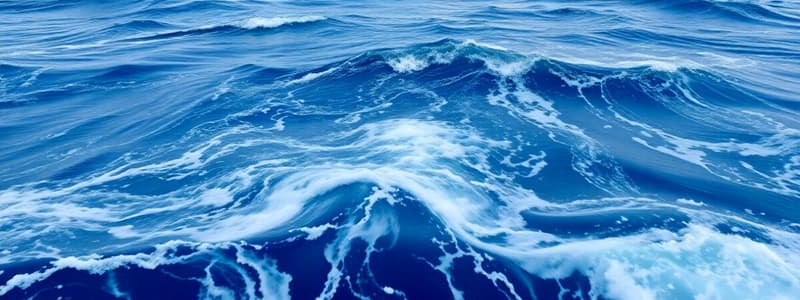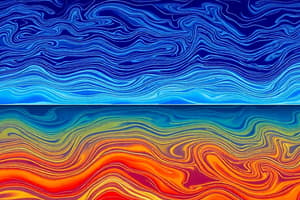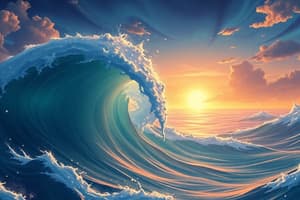Podcast
Questions and Answers
What key concept, explained in Stommel's 1948 publication, significantly influences the intensity and location of currents like the Gulf Stream?
What key concept, explained in Stommel's 1948 publication, significantly influences the intensity and location of currents like the Gulf Stream?
- The role of underwater geological formations in redirecting deep ocean currents.
- The impact of tidal forces generated by the gravitational pull of the moon and sun.
- The principles of thermodynamics related to heat transfer between the ocean and the atmosphere.
- The combined effects of fluid dynamics, Earth's curvature, and the Coriolis effect. (correct)
How do thermohaline effects, as studied by Stommel, contribute to the global ocean circulation?
How do thermohaline effects, as studied by Stommel, contribute to the global ocean circulation?
- They primarily influence surface-level currents through direct wind action on varying water densities.
- They drive deep-ocean circulation by creating density differences due to temperature and salinity variations. (correct)
- They cause localized upwelling and downwelling, which redistribute nutrients in coastal regions.
- They affect the chemical composition of seawater, altering the solubility of gases and minerals.
What was the primary focus of the PANULIRUS research station set up by Stommel in Bermuda?
What was the primary focus of the PANULIRUS research station set up by Stommel in Bermuda?
- Studying the migratory patterns of marine species affected by ocean currents.
- Monitoring the impact of pollution on coral reef ecosystems.
- Gathering extensive data on seawater properties and ocean conditions over time. (correct)
- Testing new technologies for underwater exploration and mapping.
According to scientific understanding influenced by Stommel's work, what is the main driving force behind surface-level ocean currents versus deep-ocean circulation?
According to scientific understanding influenced by Stommel's work, what is the main driving force behind surface-level ocean currents versus deep-ocean circulation?
In what way did Stommel's explanation of the Gulf Stream's dynamics represent a shift in oceanographic study?
In what way did Stommel's explanation of the Gulf Stream's dynamics represent a shift in oceanographic study?
What phenomenon occurs when sea ice forms at the poles, according to the concepts developed by Stommel and his colleagues, and how does it affect ocean circulation?
What phenomenon occurs when sea ice forms at the poles, according to the concepts developed by Stommel and his colleagues, and how does it affect ocean circulation?
What broader understanding did Stommel's studies on thermohaline effects contribute to in the field of oceanography?
What broader understanding did Stommel's studies on thermohaline effects contribute to in the field of oceanography?
How did Stommel's approach to oceanography influence the methodologies of later oceanographic studies?
How did Stommel's approach to oceanography influence the methodologies of later oceanographic studies?
Flashcards
Henry Stommel
Henry Stommel
Oceanographer who transformed the field and explained forces driving ocean currents like the Gulf Stream.
Coriolis Effect
Coriolis Effect
Moving objects are deflected to one side due to Earth's rotation, influencing ocean currents.
Westward Intensification
Westward Intensification
Stronger currents on the western edges of ocean basins due to fluid dynamics, Earth's curvature, and the Coriolis effect.
Gulf Stream
Gulf Stream
Signup and view all the flashcards
Thermohaline Circulation
Thermohaline Circulation
Signup and view all the flashcards
Sea Ice Formation Effect
Sea Ice Formation Effect
Signup and view all the flashcards
Global Ocean Circulation
Global Ocean Circulation
Signup and view all the flashcards
Great Ocean Conveyor Belt
Great Ocean Conveyor Belt
Signup and view all the flashcards
Study Notes
- Henry Stommel transformed oceanography into a major scientific field by explaining the forces behind ocean currents like the Gulf Stream.
- He combined intellect with a passion for the sea.
Career
- He studied astronomy at Yale University and taught there for 2 years.
- In 1944, he joined the Woods Hole Oceanographic Institution (WHOI).
- He held oceanography posts at Harvard and MIT.
- He eventually returned to WHOI.
Fluid Dynamics
- In 1948, Stommel's paper explained how fluid dynamics, Earth's curvature, and the Coriolis effect cause stronger currents on the western boundaries of ocean basins.
- His solution explained the position and intensity of the Gulf Stream.
- The paper opened up a new area of study: large-scale ocean circulation dynamics.
Seawater Sampling
- In 1954, He set up the PANULIRUS research station in Bermuda, which gathered extensive data.
Best-Known Text
- In 1958, he published "The Gulf Stream" after studying the current's global context for a decade.
Academic Interlude
- In 1959, he became a professor of oceanography at Harvard where he published early theories on thermohaline effects.
Global Ocean Circulation
- Stommel and colleagues developed a theory of global ocean circulation with work on thermohaline effects
- Sea ice formation at the poles increases seawater salinity and density, causing it to sink, pulling in warmer water and creating a conveyor belt.
- Surface-level currents are wind-driven, but thermohaline forces drive deep-ocean circulation.
- Stommel oversaw two major global studies of ocean processes.
National Medal
- In 1989, Stommel was awarded the United States National Medal of Science for his work on the physics of ocean currents.
Quote
- "Science is a voyage … and an expression of the human spirit.” - Henry Stommel, 1989
Studying That Suits You
Use AI to generate personalized quizzes and flashcards to suit your learning preferences.





